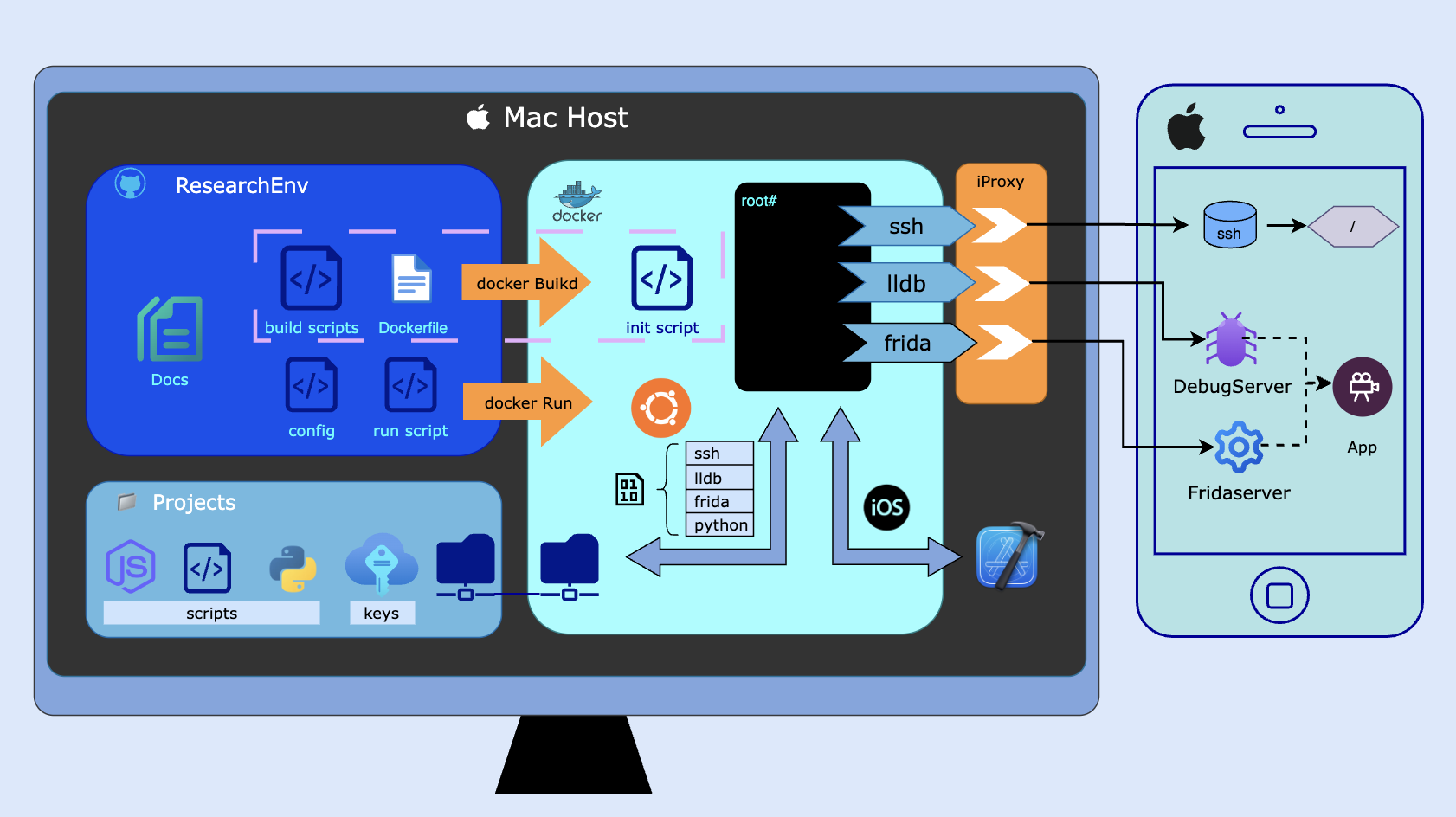____| \
| | | _ / _ / _ \ __| _ \ __ `__ \ _ \ __| _ \
__| | | / / __/ | ___ \ | | | ( | | __/
_| \__,_| ___| ___| \___| _| _/ _\ _| _| _| \___/ _| \___|
May 30, 2025
iOS Research Docker Environment

Introduction
Hello,
In this (first) post I will be presenting a project I started in late 2024.
I was about to switch jobs, and I wanted my research environment (macOS)
to be portable so I could quickly set it up once I got my new (macOS) laptop.
This gave birth to the idea of dockerizing my environment, scripts, and tools, uploading everything to GitHub, and then simply pull and build it on my next machine.
It took a couple of weeks of working nights, but eventually it worked. I have also improved it since, and added scripts, features, configurations, and improved portability.
Ideally I would have shared the entire thing, including my scripts and tools, but licensing made that complex, so I’m sharing only the environment-setup files, and instructions on how to add your own scripts
From docker to scripts
My naive approach was to create a Dockerfile that installs SSH, Frida, and LLDB, add it to a repo that contains some scripts, and port it across machines.
If that is the case, I may as well set up a
So, ideally, I wanted all of these to work: a container that is portable, configurable, minimal, easy to use, separates the environment from my projects, as automatic and as scriptable as possible, and flexible in case I want to switch tools, scripts, and projects. And after making it work, share it with the world (or at least with you, in case you are still reading)
Problems along the way
USB - a container is not able to recognize a device that is connected via USB (at least from my research on a Mac). I needed some other solution, which was combining iProxy with network-based communication (i.e., Frida and LLDB remote-server style) and port sharing and forwarding between the container, host, iproxy, and the device
Password prompts - whenever ssh-ing into the device a password is requested. Running scripts to, for example, find the PID of the target needs to be seamless. This was possible by sharing SSH key pairs and known-hosts entries between the device and the container. The location of the keys is outside of the repo and is configurable. See the docs for ssh setup.
iOS symbols - In a regular LLDB client, the debugger looks for the symbols in Xcode subfolders (after selecting the platform to remote-ios). However, inside the Docker container we use a Linux build, which does not search for that path. While LLDB has many configuration options and environment variables, the debug symbols is not one of them (at least with the version I was working with). This required patching one of LLDB libraries to look for the symbols in that path, while mounting the host Xcode's path to the container’s fake Xcode path. The fun part about solving this was debugging LLDB with LLDB. Good times.
Ports - Since I wanted a script the “does it all”, including setting up the ports, iproxy, and connecting to the device, I had to make sure to kill all the previous connections that were using these ports (from a previous run, for example). This required running netstat to find the PID that uses the ports, killing them, setting iproxy, using socat for packet forwarding, and everything should be done 3 times - one set of ports for ssh, one for LLDB and one for frida.
root/rootless - When cloning the repo to the new machine for
the first time, I was also working with a newer device and the concept
of rootless Jailbreak. This required some more configuration fields like
Teasers
This section contains examples of what using this setup looks like once everything is configured.
Example 1
Running
host$ ./build_and_run_docker
docker# ./debugThe first line performs the following:
- imports your configuration
- sets up the host ports, packet forwarding, and iproxy
- builds the container
- runs the container and mounting the project and scripts folders
- copies your ssh keys into the container
- sets up the patched lldb
- creates convenient aliases inside the container
The second line performs the following:
- imports your project and target-specific configuration
- finds the PID of your target using ssh (or waitfor by process name)
- starts the configured tool (lldb/frida/frida-python)
- connects to/spawns the process
- loads your custom generic scripts
- loads your target-specific script, which may start setting up hooks,
breakpoints, automatically and continue running
Example 2
Running
host$ ./build_and_run_docker
docker# mysshThe first line performs the above.
The second line connects to your
device right away (saving you from running iproxy, ssh params, password, known hosts
prompt)
Example 3
Running
How to get started?
First, clone the repo and read
the README. Start with a simple task such as getting
Use the extra
guides in the docs of the repo